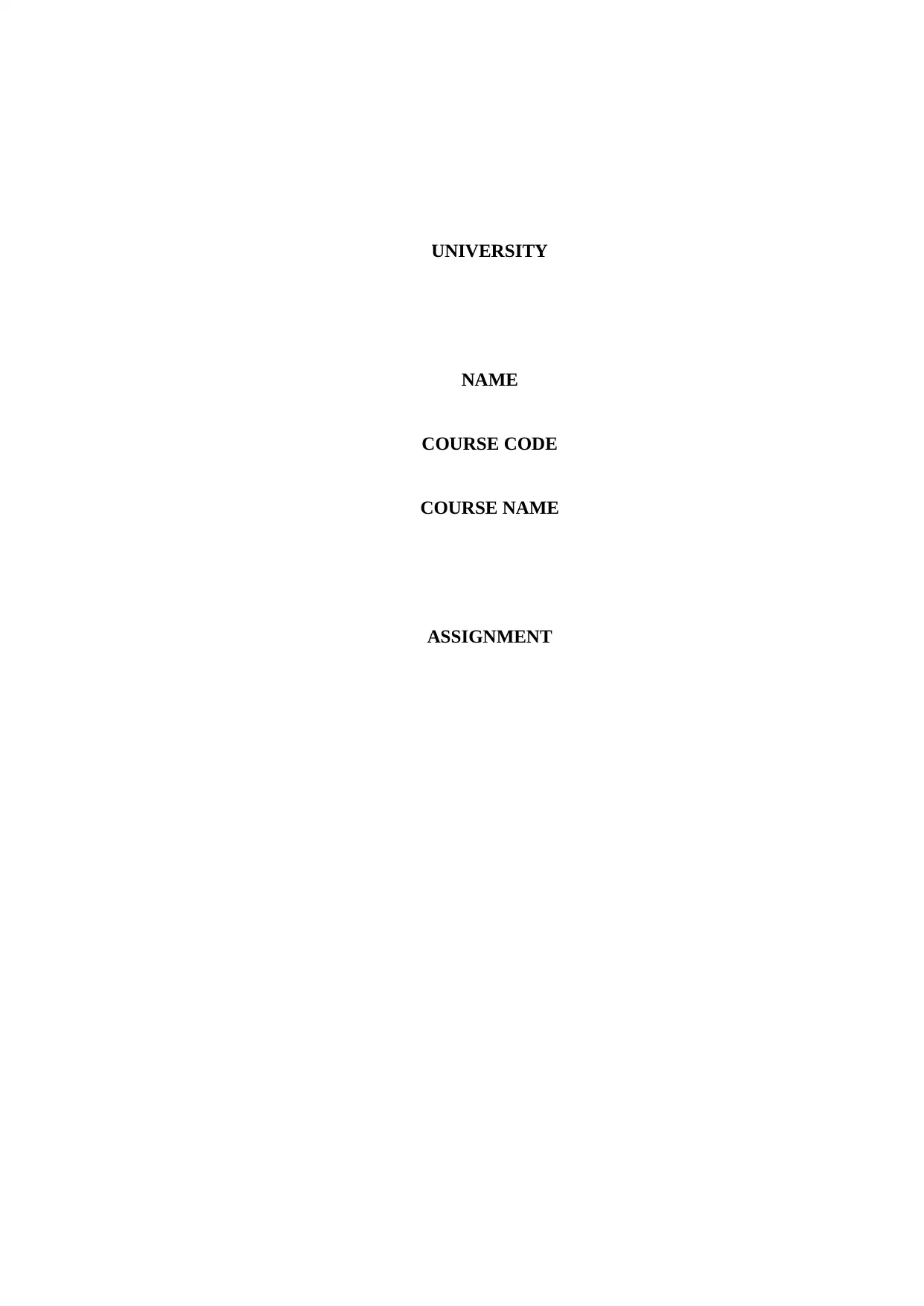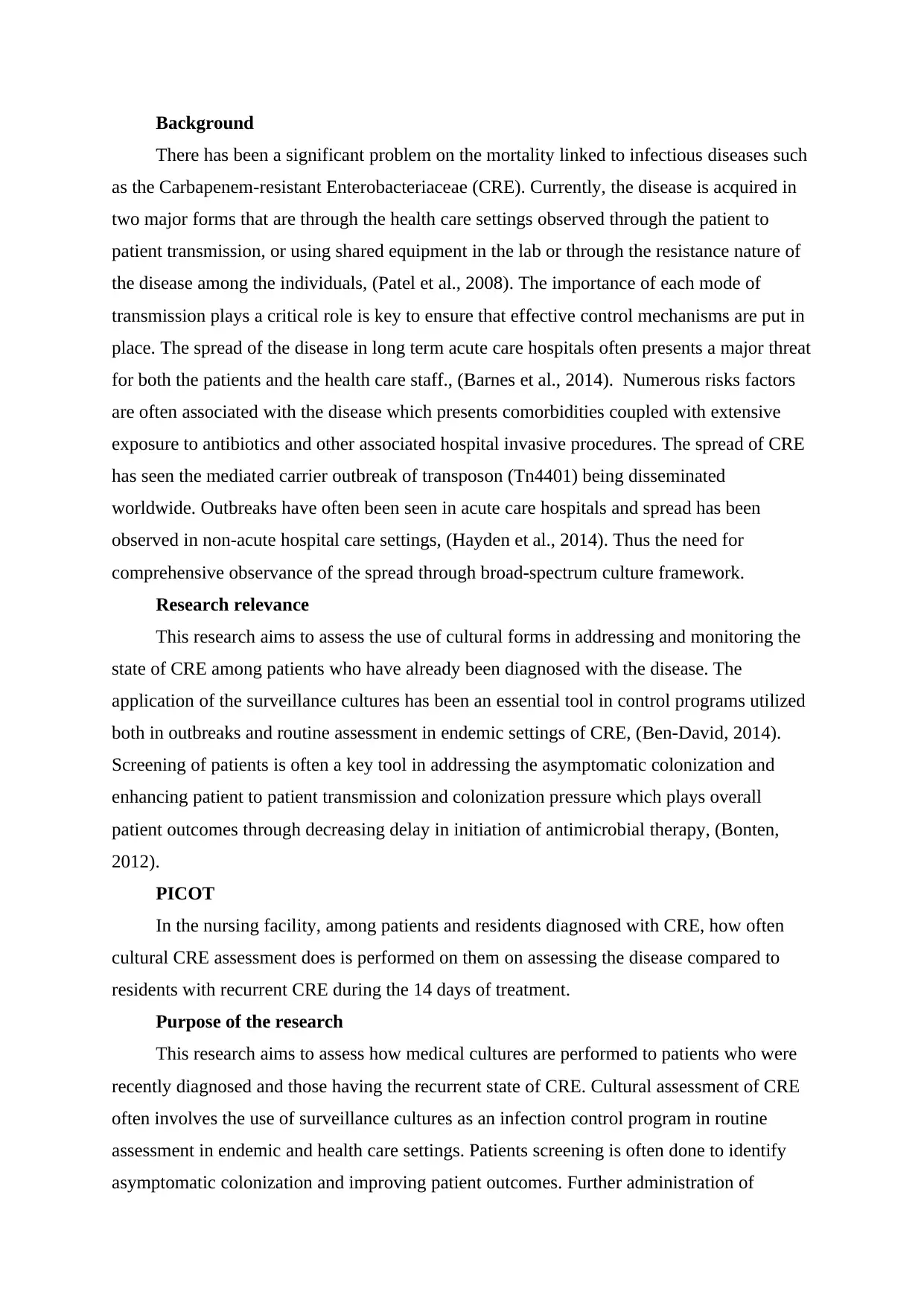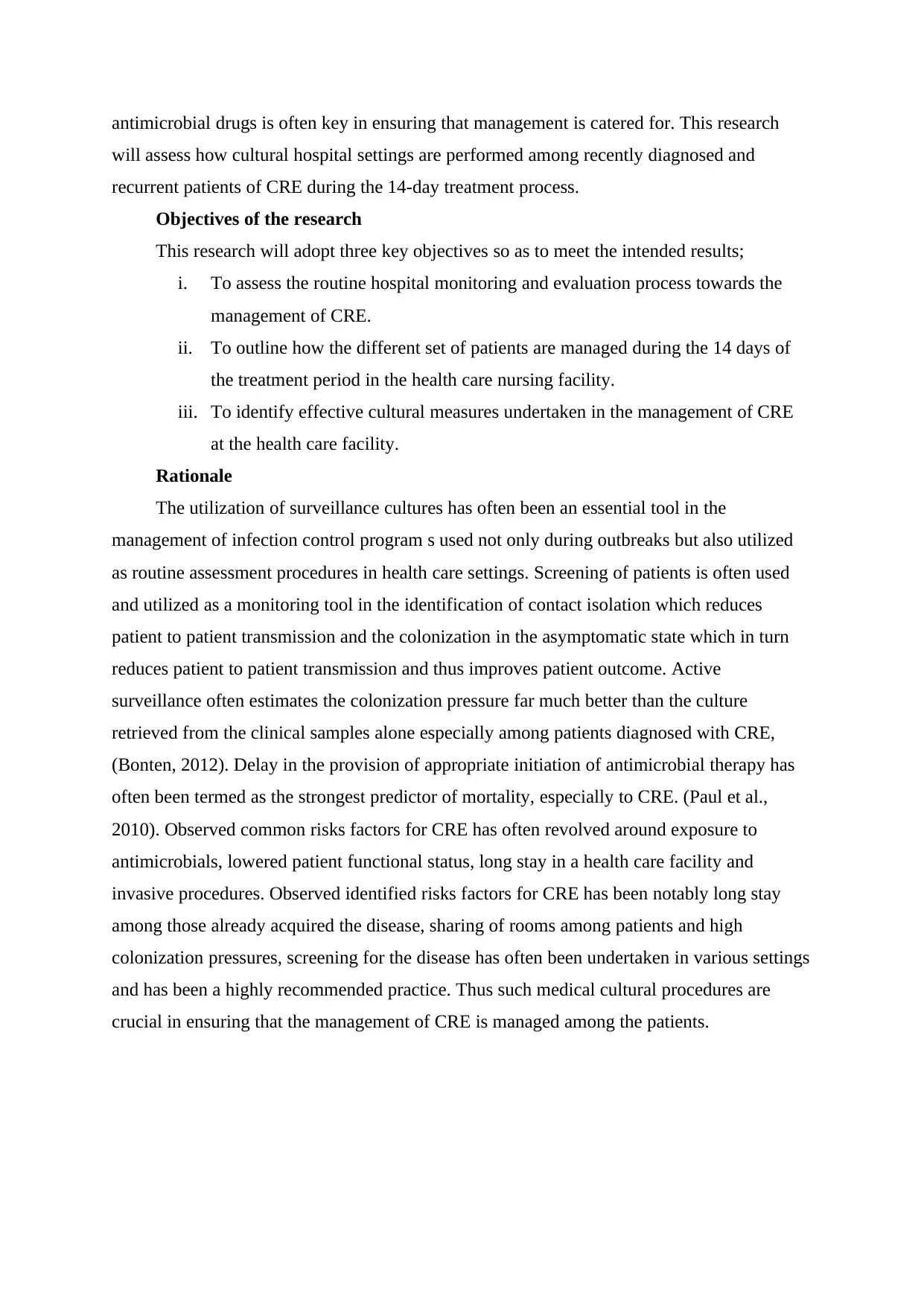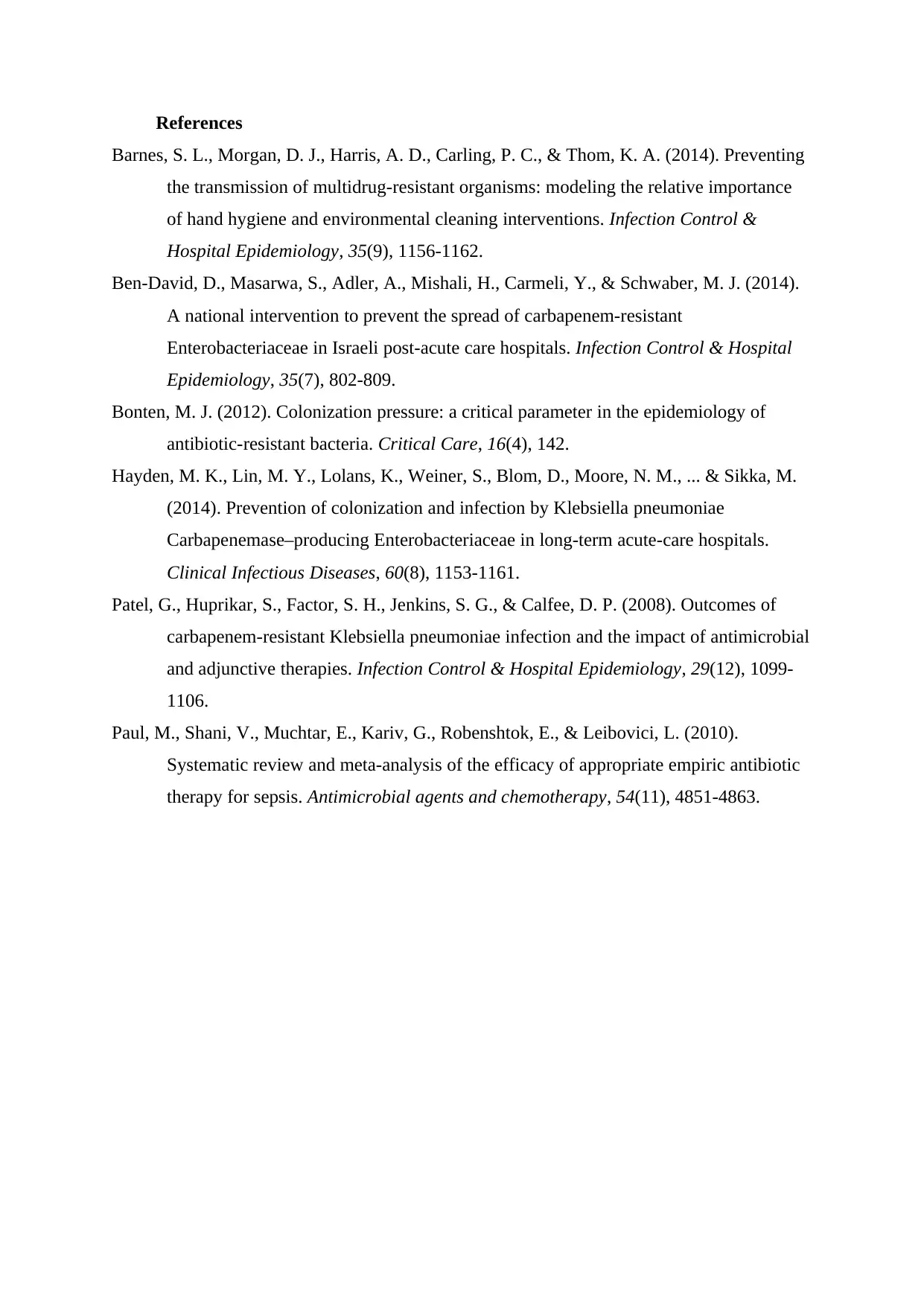Cultural Assessment in CRE Management: A Healthcare Facility Study
VerifiedAdded on 2023/04/25
|4
|1134
|168
Report
AI Summary
This report examines the use of cultural assessments in managing Carbapenem-resistant Enterobacteriaceae (CRE) within healthcare facilities. It addresses the problem of mortality linked to CRE, its transmission modes, and the importance of control mechanisms. The research aims to assess cultural forms in monitoring CRE among diagnosed patients, highlighting the role of surveillance cultures in control programs and patient screening. It focuses on comparing cultural CRE assessments in newly diagnosed versus recurrent cases over a 14-day treatment period. The objectives include evaluating routine monitoring, outlining patient management during treatment, and identifying effective cultural measures. The rationale emphasizes the significance of surveillance cultures, contact isolation, and timely antimicrobial therapy in improving patient outcomes and managing CRE risks. References to relevant studies support the findings and recommendations.

UNIVERSITY
NAME
COURSE CODE
COURSE NAME
ASSIGNMENT
NAME
COURSE CODE
COURSE NAME
ASSIGNMENT
Paraphrase This Document
Need a fresh take? Get an instant paraphrase of this document with our AI Paraphraser

Background
There has been a significant problem on the mortality linked to infectious diseases such
as the Carbapenem-resistant Enterobacteriaceae (CRE). Currently, the disease is acquired in
two major forms that are through the health care settings observed through the patient to
patient transmission, or using shared equipment in the lab or through the resistance nature of
the disease among the individuals, (Patel et al., 2008). The importance of each mode of
transmission plays a critical role is key to ensure that effective control mechanisms are put in
place. The spread of the disease in long term acute care hospitals often presents a major threat
for both the patients and the health care staff., (Barnes et al., 2014). Numerous risks factors
are often associated with the disease which presents comorbidities coupled with extensive
exposure to antibiotics and other associated hospital invasive procedures. The spread of CRE
has seen the mediated carrier outbreak of transposon (Tn4401) being disseminated
worldwide. Outbreaks have often been seen in acute care hospitals and spread has been
observed in non-acute hospital care settings, (Hayden et al., 2014). Thus the need for
comprehensive observance of the spread through broad-spectrum culture framework.
Research relevance
This research aims to assess the use of cultural forms in addressing and monitoring the
state of CRE among patients who have already been diagnosed with the disease. The
application of the surveillance cultures has been an essential tool in control programs utilized
both in outbreaks and routine assessment in endemic settings of CRE, (Ben-David, 2014).
Screening of patients is often a key tool in addressing the asymptomatic colonization and
enhancing patient to patient transmission and colonization pressure which plays overall
patient outcomes through decreasing delay in initiation of antimicrobial therapy, (Bonten,
2012).
PICOT
In the nursing facility, among patients and residents diagnosed with CRE, how often
cultural CRE assessment does is performed on them on assessing the disease compared to
residents with recurrent CRE during the 14 days of treatment.
Purpose of the research
This research aims to assess how medical cultures are performed to patients who were
recently diagnosed and those having the recurrent state of CRE. Cultural assessment of CRE
often involves the use of surveillance cultures as an infection control program in routine
assessment in endemic and health care settings. Patients screening is often done to identify
asymptomatic colonization and improving patient outcomes. Further administration of
There has been a significant problem on the mortality linked to infectious diseases such
as the Carbapenem-resistant Enterobacteriaceae (CRE). Currently, the disease is acquired in
two major forms that are through the health care settings observed through the patient to
patient transmission, or using shared equipment in the lab or through the resistance nature of
the disease among the individuals, (Patel et al., 2008). The importance of each mode of
transmission plays a critical role is key to ensure that effective control mechanisms are put in
place. The spread of the disease in long term acute care hospitals often presents a major threat
for both the patients and the health care staff., (Barnes et al., 2014). Numerous risks factors
are often associated with the disease which presents comorbidities coupled with extensive
exposure to antibiotics and other associated hospital invasive procedures. The spread of CRE
has seen the mediated carrier outbreak of transposon (Tn4401) being disseminated
worldwide. Outbreaks have often been seen in acute care hospitals and spread has been
observed in non-acute hospital care settings, (Hayden et al., 2014). Thus the need for
comprehensive observance of the spread through broad-spectrum culture framework.
Research relevance
This research aims to assess the use of cultural forms in addressing and monitoring the
state of CRE among patients who have already been diagnosed with the disease. The
application of the surveillance cultures has been an essential tool in control programs utilized
both in outbreaks and routine assessment in endemic settings of CRE, (Ben-David, 2014).
Screening of patients is often a key tool in addressing the asymptomatic colonization and
enhancing patient to patient transmission and colonization pressure which plays overall
patient outcomes through decreasing delay in initiation of antimicrobial therapy, (Bonten,
2012).
PICOT
In the nursing facility, among patients and residents diagnosed with CRE, how often
cultural CRE assessment does is performed on them on assessing the disease compared to
residents with recurrent CRE during the 14 days of treatment.
Purpose of the research
This research aims to assess how medical cultures are performed to patients who were
recently diagnosed and those having the recurrent state of CRE. Cultural assessment of CRE
often involves the use of surveillance cultures as an infection control program in routine
assessment in endemic and health care settings. Patients screening is often done to identify
asymptomatic colonization and improving patient outcomes. Further administration of

antimicrobial drugs is often key in ensuring that management is catered for. This research
will assess how cultural hospital settings are performed among recently diagnosed and
recurrent patients of CRE during the 14-day treatment process.
Objectives of the research
This research will adopt three key objectives so as to meet the intended results;
i. To assess the routine hospital monitoring and evaluation process towards the
management of CRE.
ii. To outline how the different set of patients are managed during the 14 days of
the treatment period in the health care nursing facility.
iii. To identify effective cultural measures undertaken in the management of CRE
at the health care facility.
Rationale
The utilization of surveillance cultures has often been an essential tool in the
management of infection control program s used not only during outbreaks but also utilized
as routine assessment procedures in health care settings. Screening of patients is often used
and utilized as a monitoring tool in the identification of contact isolation which reduces
patient to patient transmission and the colonization in the asymptomatic state which in turn
reduces patient to patient transmission and thus improves patient outcome. Active
surveillance often estimates the colonization pressure far much better than the culture
retrieved from the clinical samples alone especially among patients diagnosed with CRE,
(Bonten, 2012). Delay in the provision of appropriate initiation of antimicrobial therapy has
often been termed as the strongest predictor of mortality, especially to CRE. (Paul et al.,
2010). Observed common risks factors for CRE has often revolved around exposure to
antimicrobials, lowered patient functional status, long stay in a health care facility and
invasive procedures. Observed identified risks factors for CRE has been notably long stay
among those already acquired the disease, sharing of rooms among patients and high
colonization pressures, screening for the disease has often been undertaken in various settings
and has been a highly recommended practice. Thus such medical cultural procedures are
crucial in ensuring that the management of CRE is managed among the patients.
will assess how cultural hospital settings are performed among recently diagnosed and
recurrent patients of CRE during the 14-day treatment process.
Objectives of the research
This research will adopt three key objectives so as to meet the intended results;
i. To assess the routine hospital monitoring and evaluation process towards the
management of CRE.
ii. To outline how the different set of patients are managed during the 14 days of
the treatment period in the health care nursing facility.
iii. To identify effective cultural measures undertaken in the management of CRE
at the health care facility.
Rationale
The utilization of surveillance cultures has often been an essential tool in the
management of infection control program s used not only during outbreaks but also utilized
as routine assessment procedures in health care settings. Screening of patients is often used
and utilized as a monitoring tool in the identification of contact isolation which reduces
patient to patient transmission and the colonization in the asymptomatic state which in turn
reduces patient to patient transmission and thus improves patient outcome. Active
surveillance often estimates the colonization pressure far much better than the culture
retrieved from the clinical samples alone especially among patients diagnosed with CRE,
(Bonten, 2012). Delay in the provision of appropriate initiation of antimicrobial therapy has
often been termed as the strongest predictor of mortality, especially to CRE. (Paul et al.,
2010). Observed common risks factors for CRE has often revolved around exposure to
antimicrobials, lowered patient functional status, long stay in a health care facility and
invasive procedures. Observed identified risks factors for CRE has been notably long stay
among those already acquired the disease, sharing of rooms among patients and high
colonization pressures, screening for the disease has often been undertaken in various settings
and has been a highly recommended practice. Thus such medical cultural procedures are
crucial in ensuring that the management of CRE is managed among the patients.
⊘ This is a preview!⊘
Do you want full access?
Subscribe today to unlock all pages.

Trusted by 1+ million students worldwide

References
Barnes, S. L., Morgan, D. J., Harris, A. D., Carling, P. C., & Thom, K. A. (2014). Preventing
the transmission of multidrug-resistant organisms: modeling the relative importance
of hand hygiene and environmental cleaning interventions. Infection Control &
Hospital Epidemiology, 35(9), 1156-1162.
Ben-David, D., Masarwa, S., Adler, A., Mishali, H., Carmeli, Y., & Schwaber, M. J. (2014).
A national intervention to prevent the spread of carbapenem-resistant
Enterobacteriaceae in Israeli post-acute care hospitals. Infection Control & Hospital
Epidemiology, 35(7), 802-809.
Bonten, M. J. (2012). Colonization pressure: a critical parameter in the epidemiology of
antibiotic-resistant bacteria. Critical Care, 16(4), 142.
Hayden, M. K., Lin, M. Y., Lolans, K., Weiner, S., Blom, D., Moore, N. M., ... & Sikka, M.
(2014). Prevention of colonization and infection by Klebsiella pneumoniae
Carbapenemase–producing Enterobacteriaceae in long-term acute-care hospitals.
Clinical Infectious Diseases, 60(8), 1153-1161.
Patel, G., Huprikar, S., Factor, S. H., Jenkins, S. G., & Calfee, D. P. (2008). Outcomes of
carbapenem-resistant Klebsiella pneumoniae infection and the impact of antimicrobial
and adjunctive therapies. Infection Control & Hospital Epidemiology, 29(12), 1099-
1106.
Paul, M., Shani, V., Muchtar, E., Kariv, G., Robenshtok, E., & Leibovici, L. (2010).
Systematic review and meta-analysis of the efficacy of appropriate empiric antibiotic
therapy for sepsis. Antimicrobial agents and chemotherapy, 54(11), 4851-4863.
Barnes, S. L., Morgan, D. J., Harris, A. D., Carling, P. C., & Thom, K. A. (2014). Preventing
the transmission of multidrug-resistant organisms: modeling the relative importance
of hand hygiene and environmental cleaning interventions. Infection Control &
Hospital Epidemiology, 35(9), 1156-1162.
Ben-David, D., Masarwa, S., Adler, A., Mishali, H., Carmeli, Y., & Schwaber, M. J. (2014).
A national intervention to prevent the spread of carbapenem-resistant
Enterobacteriaceae in Israeli post-acute care hospitals. Infection Control & Hospital
Epidemiology, 35(7), 802-809.
Bonten, M. J. (2012). Colonization pressure: a critical parameter in the epidemiology of
antibiotic-resistant bacteria. Critical Care, 16(4), 142.
Hayden, M. K., Lin, M. Y., Lolans, K., Weiner, S., Blom, D., Moore, N. M., ... & Sikka, M.
(2014). Prevention of colonization and infection by Klebsiella pneumoniae
Carbapenemase–producing Enterobacteriaceae in long-term acute-care hospitals.
Clinical Infectious Diseases, 60(8), 1153-1161.
Patel, G., Huprikar, S., Factor, S. H., Jenkins, S. G., & Calfee, D. P. (2008). Outcomes of
carbapenem-resistant Klebsiella pneumoniae infection and the impact of antimicrobial
and adjunctive therapies. Infection Control & Hospital Epidemiology, 29(12), 1099-
1106.
Paul, M., Shani, V., Muchtar, E., Kariv, G., Robenshtok, E., & Leibovici, L. (2010).
Systematic review and meta-analysis of the efficacy of appropriate empiric antibiotic
therapy for sepsis. Antimicrobial agents and chemotherapy, 54(11), 4851-4863.
1 out of 4
Related Documents
Your All-in-One AI-Powered Toolkit for Academic Success.
+13062052269
info@desklib.com
Available 24*7 on WhatsApp / Email
![[object Object]](/_next/static/media/star-bottom.7253800d.svg)
Unlock your academic potential
Copyright © 2020–2025 A2Z Services. All Rights Reserved. Developed and managed by ZUCOL.




